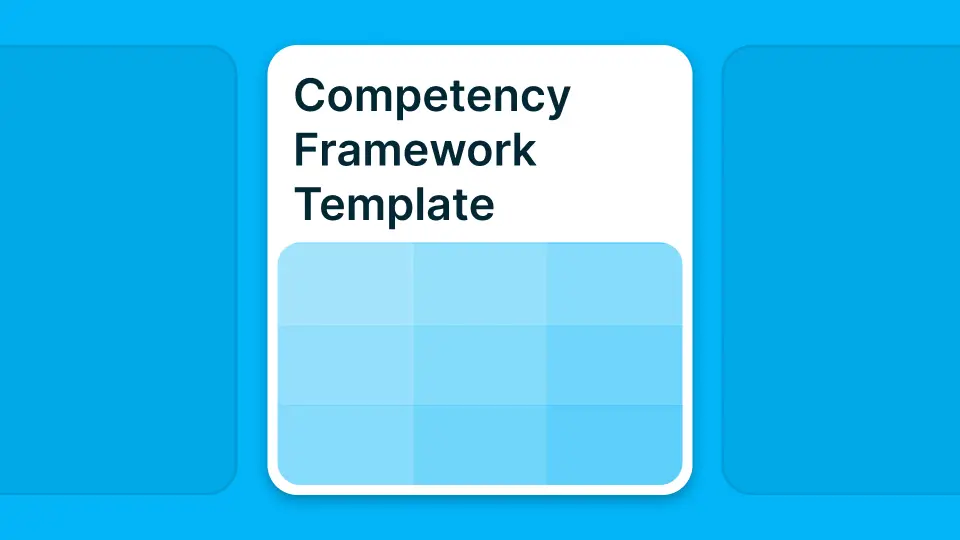Manual skill tracking in finance teams creates more problems than it solves. While 67% of finance departments still rely on scattered spreadsheets to document capabilities, they're leaving critical blind spots in roles from Accounts Payable through to Controller level. The cost? Missed training opportunities, delayed promotions, and reactive hiring when gaps become urgent.
A modern finance skills matrix template changes that equation. You get instant visibility into technical and behavioral competencies across every role—AR clerks mastering O2C cycles, General Accountants handling IFRS revenue recognition, FP&A Analysts building scenario models, Controllers overseeing SOX compliance. Downloadable templates in Excel, Google Sheets, or Notion let you start today, not next quarter.
Here's what you'll take away:
- Ready-to-use templates for AP, AR, Payroll, Accounting, FP&A, and Controller roles
- Proficiency scales with behavioral evidence—no more subjective ratings
- Assessment workflows calibrated by company size and business model
- Common pitfalls like recon debt and spreadsheet risk—plus practical fixes
- How AI platforms suggest missing skills and summarize gaps in real time
Let's break down how a finance skills matrix template works in practice—and why it's become non-negotiable for high-performing finance teams.
1. Why Finance Teams Need Role-Level Skills Matrices Now
A structured finance skills matrix template maps capabilities across all levels in one place. You see required versus actual competencies for every role—from AP clerks processing invoices to Controllers signing off on quarterly results. That clarity drives proactive upskilling and succession planning instead of firefighting when someone quits.
Companies using detailed skill matrices see up to 30% faster onboarding and internal mobility, according to LinkedIn's Workplace Learning Report 2023. When you know exactly which FP&A Analyst lacks advanced financial modeling or which Senior Accountant needs IFRS revenue recognition training, you invest learning budget where it counts.
Take a B2B SaaS firm with 200 employees. They built a multi-level matrix and discovered only one Senior Accountant understood subscription revenue accounting under IFRS 15—a single point of failure during audit season. The matrix flagged the gap six months before year-end, giving the team time to train two more people and document procedures.
Here's why finance leaders rely on these templates:
- Map required versus actual competencies by role and level—no guesswork
- Visualize skill gaps instantly through color-coded heatmaps in Excel or Sheets
- Enable data-driven learning plans tied to business priorities
- Support internal career mobility by showing promotion readiness
- Benchmark against industry standards using taxonomies like Sprad's 32,000+ mapped skills
A simple table view makes the difference tangible:
| Role | Revenue Recognition | Financial Modeling | ERP Tools |
|---|---|---|---|
| AP Clerk | 1 (Basic) | 0 (None) | 2 (Intermediate) |
| General Accountant | 3 (Advanced) | 2 (Intermediate) | 3 (Advanced) |
| FP&A Analyst | 2 (Intermediate) | 4 (Expert) | 3 (Advanced) |
Use conditional formatting in your spreadsheet to highlight cells below target proficiency in red—instant visual cues for HR and finance managers during planning reviews.
Generic job descriptions tell you someone should "maintain financial records" or "support forecasting." A finance skills matrix template shows whether your Senior FP&A person can actually build a three-statement model from scratch or just update existing tabs. That granularity changes everything.
So how do you design a matrix that reflects your business reality instead of copying templates that never fit?
2. Building Role-Specific Templates From AP Through Controller
Each finance subfunction requires distinct technical and soft skills. Customizing your matrix by role ensures relevance—AP teams focus on P2P cycle mastery, while Controllers need deep audit oversight and internal controls expertise. One-size-fits-all frameworks miss critical nuances that separate strong performers from those who struggle.
Sprad's skills taxonomy helps break down competency families like Procure-to-Pay, Order-to-Cash, GL close, reconciliation, financial modeling, variance analysis, KPI dashboards, and tax basics. Nearly half of mid-sized companies miss critical skills at the AP and AR level because they use generic frameworks that don't capture process-specific depth, according to PwC's Finance Survey.
An e-commerce startup processing thousands of daily orders realized their AR team lacked advanced ERP data handling skills—orders flowed in via Shopify and Amazon, but reconciliation depended on manual exports. Their updated matrix revealed the gap, prompting training on API connectors and automated matching rules. Time-to-close dropped from nine days to four.
Follow this approach when defining role-specific competencies:
- Define key tasks and outcomes for each role before listing competencies—what does success look like day-to-day?
- Include both technical skills (variance analysis, consolidation) and behavioral skills (stakeholder communication, deadline management)
- Layer in soft skills needed for cross-department collaboration—FP&A works with Sales, Payroll with HR
- Update the matrix as new tools or processes emerge—ERP migrations shift requirements overnight
- Link each skill to observable behaviors or evidence fields so ratings stay objective
Here's a sample extract comparing Payroll versus Senior FP&A roles:
| Role | GL Close Skill | Budgeting/Forecasting | Stakeholder Communication |
|---|---|---|---|
| Payroll Specialist | Basic | None | Intermediate |
| Senior FP&A Analyst | Advanced | Expert | Advanced |
Involve team leads when defining behavior examples per skill. A Payroll lead knows the difference between "basic GL close" (posting payroll journal entries) and "advanced GL close" (resolving multi-entity intercompany payroll allocations under tight deadlines). That frontline input makes your matrix credible.
For Accounts Payable roles, prioritize competencies like three-way matching, vendor master data management, payment run execution, accruals for unbilled invoices, and ERP navigation. For Accounts Receivable, focus on credit limit assessment, collections outreach, cash application, dispute resolution, and aging report analysis.
General Accountants need strength in full-cycle accounting—journal entries, bank reconciliations, fixed asset tracking, prepaid amortization, intercompany eliminations, and month-end close checklists. Senior Accountants add technical accounting standards (IFRS, GAAP), complex reconciliations, audit support, and process documentation.
FP&A Analysts require financial modeling, budgeting and forecasting, variance analysis, KPI dashboard creation, data manipulation in Excel or BI tools, SQL basics for data pulls, and cross-functional storytelling. Senior FP&A roles elevate that to scenario planning, driver-based models, board-level reporting, and strategic insights.
Controllers and Finance Managers oversee internal controls, SOX compliance, audit coordination, team management, policy development, close process optimization, financial statement review, and executive communication. They balance technical depth with leadership and risk management.
Now let's talk about how you actually assess proficiency—instead of just checking boxes and hoping for the best.
3. Defining Proficiency Levels With Behavioral Anchors
Using a clear proficiency scale with concrete behavior examples turns subjective gut feel into objective evidence everyone can agree on. When your scale says "Level 3 in reconciliations means independently resolving complex discrepancies within month-end deadlines," reviewers know exactly what to look for.
Teams that use behavioral anchors reduce assessment bias by up to 40%, according to SHRM research. Without anchors, two managers rate the same Senior Accountant differently—one thinks "advanced" means handling any reconciliation, the other expects automation and controls design.
A Senior Accountant at a logistics firm demonstrates Level 3 reconciliation skills by independently resolving multi-currency intercompany balances, identifying root causes of timing differences, and proposing journal entries within 48 hours of month-end. That behavior becomes the benchmark for all Senior Accountants in the matrix.
Follow these steps to define proficiency levels:
- Choose a consistent scale across all roles—five-point scales (Novice to Expert) or zero-to-four work well
- For each level and skill, define observable behavior—what does the person do, say, or deliver?
- Include an Evidence field requiring real work samples or peer feedback—no vague claims
- Train reviewers on using the scale fairly through calibration workshops with example cases
- Document calibration results after each assessment round to track inter-rater reliability
Here's a sample proficiency scale for Financial Modeling:
| Level | Description | Behavior Example |
|---|---|---|
| 1 | Basic understanding | Can update existing spreadsheet formulas and input assumptions |
| 2 | Intermediate | Builds simple models with revenue, COGS, and EBITDA projections |
| 3 | Advanced | Builds three-statement models from scratch with dynamic linking |
| 4 | Expert | Automates scenario analysis via VBA or Python; trains others |
| 5 | Thought leader | Develops modeling standards adopted across the organization |
Provide brief reviewer guides with sample evidence per role. For a Level 3 FP&A Analyst in budgeting, evidence might include a completed annual budget workbook, stakeholder sign-off emails, and variance commentary from the first review cycle.
Avoid vague descriptors like "good knowledge" or "proficient." Instead write "creates monthly variance reports within two business days, highlighting top five drivers and recommending actions." That specificity eliminates debate.
For technical accounting skills like revenue recognition under IFRS 15, Level 3 might mean "applies five-step model to standard contracts, documents judgments, and supports auditor queries." Level 4 adds "handles complex multi-element arrangements and variable consideration scenarios independently."
Soft skills need anchors too. Level 3 stakeholder communication for an FP&A Analyst could be "presents variance analysis to department heads with clear visuals, anticipates questions, and adjusts messaging based on audience." Level 4 includes "influences budget decisions through compelling storytelling and executive-level synthesis."
But even the best-designed matrices fail without regular review—and clear weighting by role to focus effort where it matters most.
4. Setting Assessment Cadence and Calibration Workflows
Regular reviews keep your skills data current—and weighting by role ensures strategic focus where it matters most. Stale data leads to wrong training investments, missed promotions, and surprise gaps during audits or departures.
Industry guidance recommends quarterly or biannual assessments depending on company growth rate. Fast-scaling startups benefit from quarterly check-ins because roles evolve rapidly. Mature enterprises can run biannual cycles unless major system or process changes occur.
Only 28% of organizations revisit their finance skill matrices more than once per year, leading to outdated insights, according to Deloitte's Human Capital Trends report. That means seven in ten companies make decisions on data that's 12 to 24 months old—ancient history in today's environment.
A multinational manufacturing company runs biannual peer-plus-manager reviews for its finance team. They weight technical skills heavily for FP&A roles (70% of total score) but emphasize process compliance and controls for Payroll and AP roles (60% process, 30% technical, 10% soft skills). Controllers get balanced weighting—40% technical, 40% process, 20% leadership and communication.
Here's how to structure your assessment workflow:
- Set review cadence based on business needs—quarterly for fast-changing orgs, biannual otherwise
- Assign weights by role and competency family based on impact and risk profile
- Combine self-assessment with manager and peer input to minimize blind spots
- Schedule calibration meetings post-assessment to align ratings across reviewers and locations
- Track changes over time—spotting improvement or regression trends easily
Sample weighting schema:
| Role | Technical Skills (%) | Process/Controls (%) | Soft Skills (%) |
|---|---|---|---|
| AP Clerk | 60 | 30 | 10 |
| General Accountant | 65 | 25 | 10 |
| Controller | 40 | 40 | 20 |
| FP&A Analyst | 70 | 10 | 20 |
Use Google Sheets add-ons or Notion formulas to automate reminders and calculations. Set up email triggers two weeks before assessment deadlines, and build dashboards that show completion rates by department.
Calibration meetings prevent rating inflation. Bring together managers who assessed similar roles and compare notes. If one manager rated three Accountants at Level 4 for GL close while another rated similar performers at Level 3, discuss the evidence and agree on a consistent standard.
Document those calibration decisions in a shared log. Next cycle, reviewers reference past cases to maintain consistency. Over time, you build institutional knowledge about what each proficiency level truly means in your context.
Track skill trends in aggregate. If average proficiency in financial modeling drops quarter-over-quarter, investigate—did you hire junior staff, lose a key trainer, or skip learning opportunities due to workload?
Of course, not every organization looks the same. Your approach should flex based on company size and business model.
5. Adapting Templates By Company Size and Business Model
Skill priorities shift dramatically between small startups and global enterprises—or between B2B SaaS operations and e-commerce businesses. What works for a 50-person software company won't fit a 500-employee logistics provider.
Sprad's Atlas AI identifies unique competency patterns based on organization type and business model, analyzing data across thousands of roles. In companies under 100 employees, multitasking is cited as a top required skill because Accountants handle AP, AR, payroll, and reporting. Above 500 employees, focus shifts toward specialization and internal controls, according to CFO.com surveys.
A B2B SaaS scaleup at 120 employees uses its matrix to cross-train Accountants in SQL basics and dashboard building. Revenue recognition under ASC 606 is critical because subscription contracts involve performance obligations and variable consideration. Their FP&A team needs cohort analysis skills to model churn and expansion revenue—competencies irrelevant to a retail business.
An e-commerce retailer with 300 staff prioritizes Order-to-Cash process depth in AR and AP roles due to high transaction volumes. Inventory accounting, returns processing, payment gateway reconciliation, and fraud detection matter more than complex financial modeling. Their matrix reflects those operational realities.
Tailor your matrix using these guidelines:
- For teams under 50: combine roles into broader categories and prioritize generalists who flex across processes
- For mid-size firms around 200 employees: differentiate by seniority but maintain some cross-functionality
- For large organizations above 500: create granular matrices per subteam or function with specialization tracks
- Adjust KPIs and evidence fields by business model—SaaS emphasizes MRR metrics, retail focuses on inventory turns
- Revisit structure after major organizational changes, acquisitions, or market pivots
Comparison of focus areas by size and model:
| Company Size / Model | Core Focus Skills | Tooling Required |
|---|---|---|
| Under 50 / SaaS | Data analysis, multitasking, revenue recognition | Excel, Sheets, lightweight ERP |
| Around 200 / E-commerce | O2C cycle depth, inventory accounting | ERP connectors, payment gateways |
| Above 500 / B2B | Controls, compliance, consolidation | Enterprise ERP, BI platforms |
Small teams often lack dedicated FP&A headcount, so General Accountants take on budgeting and forecasting. Your matrix should reflect those dual responsibilities—rate them on both technical accounting and basic financial modeling.
Large enterprises separate treasury, tax, and financial reporting into distinct teams. Build separate matrices for each function, but link them through shared competencies like Excel proficiency and stakeholder communication.
Business model differences extend to soft skills. SaaS finance teams collaborate heavily with Sales and Customer Success to track bookings and renewals—communication and cross-functional influence are weighted higher. Manufacturing finance teams coordinate with procurement and supply chain—process rigor and data accuracy matter more.
Even well-intentioned matrices can backfire if they're not kept relevant—or if risks like reconciliation debt and spreadsheet errors are ignored.
6. Avoiding Common Pitfalls in Finance Skills Matrices
Spreadsheet risk contributes up to seven billion dollars in losses globally each year due to manual errors and poor version control, according to MarketWatch analysis. Yet most finance teams still track skills in static Excel files with no audit trail or collaborative features.
A mid-market firm missed 500,000 dollars in receivables because manual close steps weren't mapped or owned in the old matrix. During an audit, they discovered one Accountant handled a critical reconciliation that no one else understood. When she left, the process broke—and invoices went unbilled for three months.
Flag recon debt early—don't let unreconciled balances pile up unnoticed. Include reconciliation ownership and frequency in your skills matrix. If a Senior Accountant is rated Level 3 in bank reconciliation, evidence should show they complete it within five business days every month, document exceptions, and resolve discrepancies before close.
Common pitfalls and fixes:
- Recon debt accumulates because no one owns end-to-end reconciliation—assign clear owners per account in the matrix
- Spreadsheet dependency creates single points of failure—move to shared Google Sheets with version history
- Manual close steps aren't documented—add checklist fields and assign proficiency ratings to each step
- Skills become outdated after tool migrations—schedule matrix reviews immediately after ERP or BI platform changes
- SOX controls aren't aligned with competencies—involve internal audit when defining Controller and Manager skills
Pitfall summary with risk levels:
| Pitfall | Risk Level | Fix |
|---|---|---|
| Recon debt | High | Add monthly reconciliation checks to matrix |
| Spreadsheet dependency | Medium | Move to shared Sheets with versioning and access controls |
| Manual close steps | High | Assign owners plus checklist fields per close task |
| Outdated skills post-migration | Medium | Trigger matrix review within 30 days of system changes |
| SOX gaps | High | Involve audit team in defining Controller competencies |
Leverage audit-ready templates where possible. Include fields for control descriptions, testing frequency, and evidence retention. When auditors ask "who can perform this control," your matrix provides the answer with proficiency ratings and training records.
Run annual risk reviews with internal audit and compliance teams. Identify which skills protect against material misstatement or fraud—rate those as critical and require higher proficiency levels plus backup coverage.
Avoid treating the matrix as a one-time project. Markets shift, tools evolve, and teams grow. Build a review cadence into your finance calendar—right after annual budgeting or mid-year forecasting when you're already thinking about capabilities and gaps.
So how can technology supercharge everything you've built so far?
7. Using AI and Modern Tools To Automate Skill Tracking
Next-gen platforms can automatically suggest missing skills and summarize gaps—saving hours while improving accuracy. Manual tracking means someone reviews job descriptions, interviews managers, and updates spreadsheets. AI tools like Sprad's Atlas AI leverage a database of over 32,000 mapped skills plus machine learning models trained on real-world organizational data.
Teams using automated skill suggestion save an average of four hours per assessment cycle versus manual updates alone, based on Sprad internal benchmarking. That time goes toward coaching conversations and training design instead of data entry.
A private equity-backed group rolled out Atlas AI recommendations alongside their Google Sheets tracker. The result? Sharper focus on emerging BI and data science needs not previously captured. The AI flagged that none of their FP&A Analysts had SQL or Python skills—competencies increasingly required for self-service analytics.
How AI-powered tools enhance your finance skills matrix template:
- Import your current matrix into an AI platform for instant gap detection across roles
- Auto-suggest new or emerging competencies as market demands shift—AI monitors job postings and skill trends
- Summarize gaps visually through dashboards you can share directly with executive stakeholders
- Integrate HRIS and performance data feeds where possible for real-time proficiency updates
- Build custom reports segmented by location, team, or business unit for targeted interventions
Feature comparison between manual and AI-powered tracking:
| Feature | Manual Tracking | With Atlas AI |
|---|---|---|
| Gap detection | Quarterly review cycles | Real-time alerts |
| New skill alerts | None—rely on manager awareness | Automated suggestions based on industry trends |
| Reporting | Static Excel exports | Live dashboards with drill-down capability |
| Proficiency evidence | Manual upload of documents | Linked to performance reviews and 1:1 notes |
| Calibration support | Offline meetings with printouts | Side-by-side comparison views and rating distribution analytics |
Look for tools that support both Excel export and API integrations for flexibility. You want the ability to pull data into your existing reporting stack—whether that's Tableau, Power BI, or custom dashboards.
Sprad's platform includes a 32,000+ skills taxonomy covering technical finance competencies, soft skills, and industry-specific capabilities. When you add a new role like "Revenue Accountant," Atlas AI suggests relevant skills from the taxonomy—IFRS 15 revenue recognition, contract review, deferred revenue management, audit support—saving you research time.
AI also helps with proficiency benchmarking. If your Senior FP&A Analyst rates themselves Level 4 in financial modeling, the platform can flag whether that's consistent with peers in similar roles across your industry. Outliers prompt calibration discussions.
Integrate your matrix with learning management systems. When a gap is identified—say, a General Accountant needs Level 3 in consolidation but sits at Level 2—the system can recommend specific courses or certifications and track completion.
Voice-of-employee data from engagement surveys or 1:1 meeting notes can feed into skill tracking. If multiple FP&A Analysts mention struggling with a new BI tool, Atlas AI surfaces that theme and suggests adding the tool to the skills matrix with current proficiency ratings.
Predictive analytics take it further. Platforms can flag flight risk when someone's skill development has stalled—no progression in two assessment cycles might signal disengagement. Proactive conversations happen before resignation letters arrive.
Conclusion: Future-Proofing Your Finance Team Through Structured Skill Mapping
Three insights stand out. First, a well-built finance skills matrix template makes hidden strengths and weaknesses visible—for every role from AP through Controller. You stop guessing where gaps exist and start making evidence-based decisions about training, hiring, and promotions.
Second, regular assessments calibrated by role keep your people data current and ready for whatever comes next. Quarterly or biannual reviews with clear proficiency scales and behavioral anchors eliminate subjectivity. You know exactly who can step into critical roles during growth, departures, or system changes.
Third, tech-enabled approaches cut risk while surfacing new priorities as your business evolves. AI platforms like Sprad's Atlas AI suggest emerging competencies you might miss manually—SQL for FP&A teams, API knowledge for AR specialists, advanced controls for newly public companies.
Next steps for HR and finance leaders:
- Download the right templates by department and level today—even if starting small with one team
- Engage team leads when defining behavioral benchmarks per role and competency family
- Commit to at least biannual reviews and consider automating where possible to reduce admin burden
- Link skill data to development plans, performance reviews, and succession planning
- Track skill trends over time to spot systemic gaps or training effectiveness
As automation reshapes finance work and regulations keep shifting, your ability to map and close skills gaps will set your team apart. Controllers who can't adopt new tools fall behind. FP&A teams without data science skills lose influence. Accountants stuck in manual processes become bottlenecks.
The organizations winning today treat skills as dynamic assets requiring continuous investment and measurement. A finance skills matrix template isn't a compliance checkbox—it's the foundation for strategic workforce planning that delivers measurable business outcomes.
Frequently Asked Questions (FAQ)
What is a finance skills matrix template?
A finance skills matrix template is a structured tool used to map required versus actual competencies across various roles within your finance department—from AP clerks up through Controllers. It typically includes proficiency scales with behavioral anchors, evidence fields for objective evaluation, and weighting by competency family. The template helps HR and finance leaders visualize skill gaps, prioritize training investments, and support succession planning with data instead of gut feel.
How do I build an effective finance skills matrix from scratch?
Start by listing all core roles and functions within your team—Accounts Payable, Accounts Receivable, Payroll, General Accountant, Senior Accountant, FP&A Analyst, Controller. Then break down key technical skills (GL close, reconciliation, financial modeling, revenue recognition) and soft skills (stakeholder communication, deadline management) needed at each level. Define clear proficiency levels with behavioral anchors—what does Level 3 actually look like in practice? Use downloadable templates in Excel or Google Sheets so everyone is aligned from day one. Involve team leads when defining behavior examples to ensure credibility and relevance.
Which proficiency levels should I use when assessing my finance team?
Most companies opt for either a five-point scale ranging from Novice through Expert or a zero-to-four rating system tied directly to observable behaviors. For example, Level 1 might be "Can update existing spreadsheet formulas" while Level 4 is "Automates scenario analysis via VBA and trains others." Consistency is crucial so results are comparable across managers and reviewers. Include behavioral anchors for each level and require evidence—work samples, peer feedback, or manager observations—to support ratings and reduce bias.
How often should we assess our finance team's competencies?
For most organizations, quarterly or biannual reviews strike the right balance between currency and practicality. Fast-growing firms benefit from quarterly check-ins because roles and responsibilities evolve rapidly during scaling. Mature enterprises can run biannual cycles unless major tool implementations, process changes, or organizational restructuring occur. Always trigger an assessment within 30 days of significant changes like ERP migrations or team expansions. Track proficiency trends over time to spot improvement or regression and adjust training investments accordingly.
Can I adapt my finance skills matrix template as our business grows or pivots?
Absolutely. The best matrices are living documents that evolve with your business. As you add new roles—like Revenue Accountant or Treasury Analyst—extend the matrix with relevant competencies. When your business model shifts from product sales to subscription revenue, update skills to emphasize recurring revenue accounting and cohort analysis. After acquisitions or geographic expansion, incorporate region-specific requirements like local GAAP or statutory reporting. Schedule matrix reviews after major milestones and involve cross-functional stakeholders to ensure alignment with business strategy.












